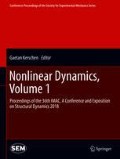Abstract
One approach for the simulation of rotating systems is the Arbitrary-Lagrangian-Eulerian (ALE) finite element formulation, which is well-established in the field of rolling contact mechanics for tires. With this formulation the rotational motion is handled from an Eulerian viewpoint and thus can be separated from the occurring Lagrangian deformation of the finite element mesh. In this context of (non-linear) systems undergoing gyroscopic and/or contact forces, e.g., for tires or disc brakes, model reduction techniques such as the Second order modal truncation, the Krylov subspace technique and the Craig-Bampton method are employed and analysed in their applicability.
Access this chapter
Tax calculation will be finalised at checkout
Purchases are for personal use only
Notes
- 1.
This stands in agreement with the fact that the spectrum of eigenvalues and thus the eigenvectors for quadratic eigenvalues problems are (at least) symmetric about the real axis.
- 2.
Inner/outer diameter di = 50 mm and da = 300 mm, thickness t = 10 mm, Young’s modulus E = 2.1 ⋅ 105 MPa, Poisson ratio ν = 0.3.
- 3.
α = 0, β = 1 ⋅ 10−6.
- 4.
References
Gasch, R., Knothe, K., Liebich, R.: Strukturdynamik: Diskrete Systeme und Kontinua. Springer, Berlin (2012)
Ewins, D.J.: Modal Testing: Theory, Practice and Application, 2nd edn. Research Studies Press, Baldock/Philadelphia (2000); Previous edition (1995)
Salimbahrami, B.: Structure preserving order reduction of large scale second order models. PhD thesis, Lehrstuhl für Regelungstechnik, Technische Universität München (2005)
Villemagne, C.D., Skelton, R.E.: Model reductions using a projection formulation. Int. J. Control. 46(6), 2141–2169 (1987)
Freund, R.W.: Krylov-subspace methods for reduced-order modeling in circuit simulation. J. Comput. Appl. Math. 123(1), 395–421 (2000)
Arnoldi, W.E.: The principle of minimized iterations in the solution of the matrix eigenvalue problem. Q. Appl. Math. 9(1), 17–29 (1951)
Lanczos, C.: An iteration method for the solution of the eigenvalue problem of linear differential and integral operators. J. Res. Natl. Bur. Stand. B 45, 255–282 (1950)
Lohmann, B., Salimbahrami, B.: Reduction of second order systems using second order Krylov subspaces. IFAC Proc. Vol. 38(1), 614–619 (2005). 16th IFAC World Congress
Salimbahrami, B., Lohmann, B.: Order reduction of large scale second-order systems using Krylov subspace methods. Linear Algebra Appl. 415(2), 385–405 (2006). Special Issue on Order Reduction of Large-Scale Systems
Bampton, M.C.C., Craig, R.R., Jr.: Coupling of substructures for dynamic analyses. AIAA J. 6, 1313–1319 (1968)
Nackenhorst, U.: The ALE-formulation of bodies in rolling contact: theoretical foundations and finite element approach. Comput. Methods Appl. Mech. Eng. 193(39), 4299–4322 (2004)
Nackenhorst, U.: Rollkontaktdynamik, Numerische Analyse der Dynamik rollender Körper mit der Finite Elemente Methode. Habilitation, Institut für Mechanik, Universität der Bundeswehr Hamburg (2000)
Willner, K.: Kontinuums- und Kontaktmechanik: Synthetische und Analytische Darstellung. Springer, Berlin/Heidelberg (2003)
Geisler, J., Willner, K.: Modeling of jointed structures using zero thickness interface elements. PAMM 7(1), 4050009–4050010 (2007)
Ziefle, M., Nackenhorst, U.: Numerical techniques for rolling rubber wheels: treatment of inelastic material properties and frictional contact. Comput. Mech. 42(3), 337–356 (2008)
Genta, G.: Dynamics of Rotating Systems. Mechanical Engineering Series. Springer, New York (2005)
Bryan, G.H.: On the beats in the vibrations of a revolving cylinder or bell. Proc. Camb. Philos. Soc. 7(3), 101–114 (1890)
Joubert, S.V., Fedotov, I., Pretorius, W., Shatalov, M.: On gyroscopic effects in vibrating and axially rotating solid and annular discs. In: 2007 International Conference – Days on Diffraction, pp. 89–94 (2007)
Farhat, C., Avery, P., Chapman, T., Cortial, J.: Dimensional reduction of nonlinear finite element dynamic models with finite rotations and energy-based mesh sampling and weighting for computational efficiency. Int. J. Numer. Methods Eng. 98(9), 625–662 (2014)
Author information
Authors and Affiliations
Corresponding author
Editor information
Editors and Affiliations
Rights and permissions
Copyright information
© 2019 The Society for Experimental Mechanics, Inc.
About this paper
Cite this paper
Weidauer, T., Willner, K. (2019). Reduced Order Modelling for Non-linear Rotating Systems in ALE Formulation with Contact. In: Kerschen, G. (eds) Nonlinear Dynamics, Volume 1. Conference Proceedings of the Society for Experimental Mechanics Series. Springer, Cham. https://doi.org/10.1007/978-3-319-74280-9_31
Download citation
DOI: https://doi.org/10.1007/978-3-319-74280-9_31
Published:
Publisher Name: Springer, Cham
Print ISBN: 978-3-319-74279-3
Online ISBN: 978-3-319-74280-9
eBook Packages: EngineeringEngineering (R0)

